| HOME • FAMILY • YESTERDAY • SOLVAY • STARSTRUCK • MIXED BAG |
 |
(continued . . . ) My favorite SU football radio memory also was on a November 24, but in 1951, when the underdog Orange rallied from a 19-6 halftime deficit to beat Boston University, 26-19, establishing momentum that continued through the 1952 season when Syracuse went to the Orange Bowl, its first post-season game. For several seasons the announcer for Syracuse football games was WSYR’s Bill O’Donnell, who would go on to become the voice of the Baltimore Orioles. I have a vague recollection that for awhile early in his career O’Donnell was known as Bill Martin. I’m probably wrong. In any event, it has nothing to do with this story. O’Donnell had a great radio voice, but sometimes gave credit to the wrong ball carrier, receiver or tackler. It may be that he had poor spotters. I was familiar enough with the SU teams, having watched them in person at all of their home games for several years, to know Coach Ben Schwartzwalder’s game plans and his substitution tendencies. And at some point O’Donnell would say “So-and-So” picked up six yards on the scissors play and I would know that “So-and-So” was never used on the scissors play, so I’d shout the correct name at the radio and seconds later O’Donnell would correct himself as though he had heard me. (I don't think it was ever identified as such in the movie, but the scissors play was featured in "The Express." I always thought of it as an inside reverse. Whatever, when Ernie Davis was involved, the scissors play worked to perfection.) Another Syracuse sports announcer was Red Parton who at one time had a daily 15-minute show on WOLF. For reasons unknown, Parton used a University of Illinois song (“We’re I don't listen to the radio anymore. Haven't done so since I started programming my own music. That's why my most recent radio memory goes way back. It involves Syracuse University's football team which in 1979 was showing signs of coming out of a long slump, but in those days you wouldn't find games all over the tube like you do today. To follow SU, I had to use the radio, except I lived in Rhode Island and the closest station that carried the games was in New York City. I discovered I could pick up that station on our car radio, but as much as I loved the Orange, I wasn't about to drive around for three hours every Saturday afternoon, and I didn't want to tax the car battery by listening while my car was parked in our driveway. So I did it in short bursts, going to the car every ten minutes or so, listening to a few plays, then returning to whatever I was doing in the house. I even did this on a weekend my in-laws were visiting from Hilton Head. My mother-in-law thought I was nuts, but my father-in-law understood. He had gone to Auburn University and was even crazier about their football team than I was about the Orange. (Needless to say, neither of us was pleased when Syracuse and Auburn played to a tie in the 1988 Sugar Bowl.) Send in the clowns To me, it's especially unfair that a slapstick act like The Three Stooges endures while similarly inspired radio silliness is generally forgotten. I admit it, as a young boy I loved the Stooges. I loved The Bowery Boys (aka Dead End Kids and East Side Boys). But I also loved Baby Snooks, who could exist Radio featured several comedians who were equally at home in the movies and would easily make the transition to television. Bob Hope and Red Skelton topped that list. In his prime, Hope was the funniest guy around. Or maybe it was Jack Benny, who actually made a few good movies, but was constantly making fun of them, particularly one called "The Horn Blows at Midnight." Benny's radio show was always a treat. The format of his later television show, also excellent, was very similar. Fred Allen's radio show was one of the funniest, featuring several amusing characters he encountered along Allen's Alley. My favorites were Minerva Pious who played Mrs. Nussbaum and Kenny Delmar, who played blowhard Sen. Claghorn. Also on the show was Alan Reed (as Falstaff Openshaw), one of several radio shows he did before he became better known as the voice of Fred Flintstone. One of the important differences between today's entertainment and yesterday's was how producers, more often than not, resisted the temptation to give supporting performers more exposure. Few of the many great character actors of the 1930s, '40s and '50s ever overstayed their welcomes. Today there's a tendency to try to turn everyone into a star, which explains why so many "Saturday Night Live" performers have made so many terrible movies. Also, despite the negative press the show received for several years after it left the air, "Amos and Andy" was a funny, funny show, at least on radio where voices counted and faces didn't matter. Only on radio could one actor convincingly play more than one role. I thoroughly enjoyed "The Life of Riley," but never realized an actor named John Brown played both Riley's best pal, Gillis, and the show's funniest character, Digby "Digger" O'Dell, "the friendly undertaker." William Bendix's success as Riley ("What a revoltin' development this is!") tended to make folks forget what a versatile actor he was. (His biggest mistake was playing the title role in "The Babe Ruth Story," a terrible, terrible movie, but he delivered the goods in his other films, alternating between funny sidekick and scary villain.) Only on radio could a mediocre ventriloquist become a big star. Mind you, Edgar Bergen was a funny, funny man, and his creations, Charlie McCarthy and Mortimer Snerd, were the products of genius. But Bergen never mastered the art of keeping his mouth closed when he talked for his puppets. He and radio suited each other perfectly.
I also enjoyed "The Great Gildersleeve," which like several radio hits inspired a series of movies and a later television version. Throckmorton P. Gildersleeve was a bag of wind created for "Fibber McGee and Molly," then was spun off on his own. Radio pretty much rescued Jimmy Durante, who was badly used by Hollywood, though truth be told, Durante was better heard than seen. He became half of radio's oddest couple when he teamed with the much younger Garry Moore, who held up his end of the partnership very well before striking out on his own in television. Another favorite radio sitcom was “The Aldrich Family,” despite the annoying voices in the exchange that opened each episode: “HENNN-REEEEE! HENRY ALDRICH!!” “COMING, MOTHER!!” A squeaky-voiced actor named Ezra Stone made a career out of playing the teenager who was at the center of this show, which should have been called “Henry Aldrich.” Hollywood knew better, using Henry in the title of ten of the eleven movies that were made about the Aldrich family. The movies were made between 1938 and 1944, with Jackie Cooper starring in the first two, Jimmy Lydon in the rest of them. My father's favorite show for a few years was one that aired after my bedtime. As a young boy I often had trouble finding sleep and finding it was especially difficult when my father listened to Henry Morgan, whose biting wit was way ahead of his time. My father's appreciation of Morgan's comedy surprised me and his frequent outbursts of laughter not only kept me awake, but made me curious ... and envious. My father had a loud, explosive laugh, which meant that until Morgan's program was over, I might as well find a book to read. But speaking of odd couples, one of Morgan's sidekicks was Arnold Stang, who went on to a successful career in other projects, but would never be as funny as he was with Morgan. Another funny program was "Can You Top This?" in which a panel of comedians or gag writers would try to tell funnier jokes than those that had been selected from thousands that listeners submitted every week. If there were a king of radio, his name was Arthur. Arthur Godfrey, that is. He hosted a daily variety show by day, and once a week he did a nighttime talent show. Later he'd branch out into television. Everyone listened to Arthur Godfrey, though not everyone liked him. Thing is, you never knew what the guy would say, which is what made him so interesting. He was to radio what Jack Paar would become to television as host of "The Tonight Show." I guess if you were to include a Godfrey character in "Radio Days," you'd probably recall the day he fired his most popular performer, singer Julius LaRosa, breaking the news to LaRosa while they were on the air. I spent a lot of time during several summer vacations sitting in the living room with my mother, listening to "Arthur Godfrey Time." And just as recalling the names of the Seven Dwarfs or Santa's reindeer can turn into a game, a lot of oldtimers do the same with Godfrey's group of regulars. (Among them: The Chordettes, Janette Davis, Marion Marlowe, Frank Parker, The McGuire Sisters, The Mariners, LuAnn Simms, Carmel Quinn, conductor Archie Bleyer, announcer Tony Marvin and LaRosa.) And I'd be remiss if I didn't mention Art Linkletter, though I was never a fan of his program or the mileage he got out of "Kids say the darndest things") and Ralph Edwards, who struck gold twice, first with "Truth of Consequences," later with "This Is Your Life," an even bigger hit on TV. "Truth or Consequences" defies description; it was not really a quiz show, though contestants were asked a question. Thing is, most contestants wanted the consequences, stunts similar to those performed by couples featured on "The Amazing Race." Edwards promised to visit the first town willing to change its name to "Truth or Consequences," and, sure enough, he found one – Hot Springs, New Mexico, which in 1950 was the site of a name-changing broadcast. As for "This Is Your Life," I remember it mostly because I was part of a small group who did a spoof of the program at a high school talent show during my senior year at Solvay High School. We called it "This Should Have Been Your Life." The late Bill Morse played the part of Edwards and did a marvelous job. Just the facts, ma'am But once inside the house, seated by the radio during “Gangbusters,” my imagination and my fears took over, particularly at the end of the program when listeners were told about criminals on the FBI’s “most wanted list,” fugitives who could be hiding anywhere . .. like outside our house, crouched beneath a living room window! However, my favorite police drama arrived in 1949 – Jack Webb's "Dragnet," with the "Dum duh dum-dum" theme by Walter Schumann. Webb's documentary approach and terse, "Just the facts, ma'am" dialogue soon caught on, and before long the show also became a television hit. "Dragnet" probably was the most popular and the most Also, it was Webb's love of jazz that probably got me interested in Dixieland music and a popular local group, The Salt City Five (later Six). During one summer vacation for "Dragnet," Webb produced and starred in a radio show called "Pete Kelly's Blues," which he later turned into a movie. The radio show was my first exposure to Dixieland. Music becomes king As I became more and more interested in music, I drifted toward WOLF, which would become Syracuse’s top radio station after rock ‘n’ roll was born. But even in the early 1950s it had something going for it, an all-request program called “Sandman Serenade,” that ran from 10 p.m. to 2 a.m. This was before radio stations became strictly formatted. “Sandman Serenade” played a wide variety of popular music, though country records were pretty much restricted to a program called “The Buckaroos,” that ran from 9 to 10 p.m. (Note: I’ve also seen the program listed as “The WOLF Buckaroos” and “Buckaroo Sandman.” The theme song sounded more like a polka than a county/Western song. I never knew the name of that song, but I did hear it briefly during a barn dance scene in a vastly underrated 1940 Christmas movie called “Remember the Night,” with Fred MacMurray and Barbara Stanwyck. Turner Classic Movies presented it for the first time in December 2009; I think it might well become a holiday tradition a la “It’s a Wonderful Life.” Apparently it was the inspiration for a 1998 cable film, “On the 2nd Day of Christmas,” starring Mary Stuart Masterson and Mark Ruffalo.) For many years WOLF’s “Sandman Serenade” was flat-out Syracuse’s most popular radio program with young people. You’d call the station, make your request, then listen for your song to be played. The music was the star of the program; there was no Wolfman Jack wannabe behind the microphone, though I do remember a WOLF disc jockey named Gene Nelson who was especially personable and entertaining. His was an easy name to remember because it was the same as one that belonged to a dancer-actor who was doing pretty well for himself in Hollywood. Because so many people called WOLF during “Sandman Serenade,” chances are you’d get a busy signal and have to try, try again. I didn't call very often, but when I did, it was usually to request the song "Hot Toddy" by the Ralph Flanagan Orchestra. A few years later when my sister began calling the “Sandman” she encountered something beyond my understanding, something that smacked of “The Twilight Zone.” It must have started when a frustrated caller shouted “Hello! Hello!” despite the busy signal. Somehow he was heard by someone else who had just gotten a busy signal. Thus came the discovery it was possible for two people who couldn’t get through to the radio station to have a conversation with each other. The result was what dating services and the internet would become many years later. People began dialing WOLF in hopes of getting a busy signal so that they might hook up with someone. My sister never got a date from her “Sandman” experience, but she did have a few conversations with people she'd never met face to face. "American Graffiti: The Prequel" A few years later, while working as a reporter for the Syracuse Herald-Journal, I had an "American Graffiti" moment – 12 years before the movie was made. It was late one night, I was with Dalaine Barfield, the reigning Miss Syracuse. It might not have been a date – as I recall, she had a boyfriend – but the Journal was involved with the beauty pageant and I was only too happy to assist. Whatever, I was driving her home from some event when the conversation turned to music. She mentioned her favorite song – I don't recall what it was – and I told her I knew where she could hear it. This was before cell phones, so instead of calling the Sandman, I detoured to the small WOLF building in the northwest corner of Syracuse. We knocked on the door and after a few minutes a young man came to the door. I wish I could remember his name. He was hosting “Sandman Serenade” and was polite enough to ask us into the studio. He was interested that I worked at the Journal, more interested that my companion was Miss Syracuse, and he quickly honored her musical request. We stayed a few more minutes, then I drove her home. (My sister reminded me that I had done something similar with another girl, this one definitely a date. Since I don't remember the occasion, I don't know who the girl was. But my sister claims one night I brought a date home just long enough to play "Theme from 'A Summer Place'," which apparently upset my sister because the record belonged to her.) For lunch: Sandwiches and suds I figure we had a half-hour for lunch, so we probably listened to two soap operas every day. I think one of them was “The Romance of Helen Trent,” but I am not certain. Other popular soaps at the time were “Ma Perkins,” “One Man’s Family,” “Young Doctor Malone,” “Our Gal Sunday,” “Life Can Be Beautiful” and “Backstage Wife,” which featured as its leading character a woman named Mary Noble. It was a weird scene, the three of us sitting in that car listening to soap operas. Had it been in a movie, of course, the three of us would burst into tears at Helen Trent’s latest crisis. Within a week I was hooked on whatever soaps we were listening to, and the experience set me up to enjoy TV soap operas, first with my mother, later with my second wife. It was radio soap operas that inspired one of comedian Stan Freberg’s hit records, “John and Marsha,” in which he played both parts conducting three-minute conversation with only two words, “John” and “Marsha,” spoken with various inflections that covered a gamut of emotional reactions to several easily imagined problems. As for the real radio soap operas, they were gone by 1961. A lot of them had their final broadcasts on the day after Thanksgiving, 1960, which soap opera fans remember as the real Black Friday.
The announcer, hampered by a whiny, nasal voice, responded to management's prodding by creating what he considered a ridiculous persona, introducing himself on the air as Dan-Dan Dandy Dan Leonard and sounding like a used car salesman on speed. To his surprise (and perhaps dismay), management and the audience loved the character and Dan Leonard became Syracuse’s hottest deejay, eventually earning a place in the Syracuse Broadcasting Hall of Fame. Not surprisingly, to me, anyway, he left WNDR and finished his Syracuse career at WOLF. We interrupt this program . . .
Parody of a parody That year an actor-singer named Sheb Woolley, using the alias Ben Colder, wrote and recorded a song called "Don't Go Near the Eskimos." It was a spoof of "Don't Go Near the Indians," a hit the year before for Rex Allen. There was a radio team at Cleveland's KYW (a station that, along with its TV counterpart, moved to Philadelphia soon afterward as the result of some FCC ruling too complicated to explain here) . . . anyway, I don't remember the names of the two guys who did the morning program, but they were always in the market for comedy bits. So I wrote a parody of "Don't Go Near the Eskimos," which the radio guys recorded and played a few times, providing me with my fifteen minutes of fame. Had I been able to carry a tune, I would have recorded it myself. |
| HOME • CONTACT |

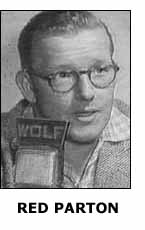 Loyal to You, Illinois”) as his theme. Finally, a few days before Syracuse played a home football game against Rose Bowl-bound Illinois in 1951, Parton substituted an SU song, either “Down, Down the Field” or “The Saltine Warrior,” I forget which. However, the next week Parton went back to the Illinois song. If a Syracuse sports announcer did that today, he or she would be chased out of town.
Loyal to You, Illinois”) as his theme. Finally, a few days before Syracuse played a home football game against Rose Bowl-bound Illinois in 1951, Parton substituted an SU song, either “Down, Down the Field” or “The Saltine Warrior,” I forget which. However, the next week Parton went back to the Illinois song. If a Syracuse sports announcer did that today, he or she would be chased out of town.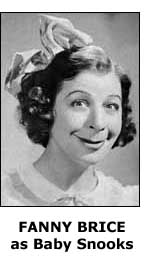 only on radio because the hilarious youngster was played by Fanny Brice, who was old enough to be Snooks' grandmother. In describing Baby Snooks, you could say she was akin to Dennis the Menace, which, while not inaccurate, doesn't do justice to Brice's portrayal. Nowadays when people think of Fanny Brice, they usually think of Barbra Streisand who became a star by playing Brice in "Funny Girl," first on Broadway, then on the movie screen. I don't recall much being made of Baby Snooks in that film, or in the sequel, "Funny Lady."
only on radio because the hilarious youngster was played by Fanny Brice, who was old enough to be Snooks' grandmother. In describing Baby Snooks, you could say she was akin to Dennis the Menace, which, while not inaccurate, doesn't do justice to Brice's portrayal. Nowadays when people think of Fanny Brice, they usually think of Barbra Streisand who became a star by playing Brice in "Funny Girl," first on Broadway, then on the movie screen. I don't recall much being made of Baby Snooks in that film, or in the sequel, "Funny Lady."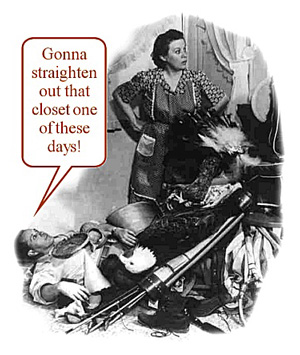 Also worth a mention is “Fibber McGee and Molly.” Like most radio comedies, there was no plot to speak off, just a parade of characters who engaged in brief conversations with Mr. and Mrs. McGee (real-life husband and wife Jim and Marian Jordan). As a teenager, my closet resembled the one Fibber McGee opened at some point in every episode when all you’d hear for several seconds was the sound of various objects tumbling to the floor.
Also worth a mention is “Fibber McGee and Molly.” Like most radio comedies, there was no plot to speak off, just a parade of characters who engaged in brief conversations with Mr. and Mrs. McGee (real-life husband and wife Jim and Marian Jordan). As a teenager, my closet resembled the one Fibber McGee opened at some point in every episode when all you’d hear for several seconds was the sound of various objects tumbling to the floor. 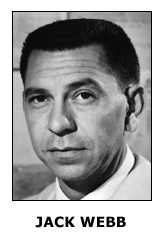 satirized police program in radio history. Stan Freberg's spoof became a hit record, "St. George and the Dragonet." Webb generally came across as humorless and he was so decidedly pro-cop that his program was viewed as propaganda for the Los Angeles Police Department. But in its day "Dragnet" was a terrific radio show. The television version, which was a hit for several years, was often hokey and unintentionally funny. As for Webb, "Dragnet" may have undermined what might have been an interesting career as a character actor. He did outstanding work early in his career when he had supporting roles in "Sunset Boulevard," "The Men" and other films. He also stole the show from Johnny Carson in a classic bit on "The Tonight Show," a routine about Cleveland kleptomaniac Claude Cooper and a caper concerning copper clappers kept in a closet. Webb managed to keep a straight face through the whole thing, never missing a beat, perfectly delivering every clever, convoluted line.
satirized police program in radio history. Stan Freberg's spoof became a hit record, "St. George and the Dragonet." Webb generally came across as humorless and he was so decidedly pro-cop that his program was viewed as propaganda for the Los Angeles Police Department. But in its day "Dragnet" was a terrific radio show. The television version, which was a hit for several years, was often hokey and unintentionally funny. As for Webb, "Dragnet" may have undermined what might have been an interesting career as a character actor. He did outstanding work early in his career when he had supporting roles in "Sunset Boulevard," "The Men" and other films. He also stole the show from Johnny Carson in a classic bit on "The Tonight Show," a routine about Cleveland kleptomaniac Claude Cooper and a caper concerning copper clappers kept in a closet. Webb managed to keep a straight face through the whole thing, never missing a beat, perfectly delivering every clever, convoluted line.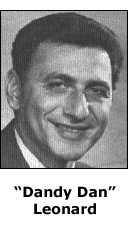 Dan, Dan, he's our man
Dan, Dan, he's our man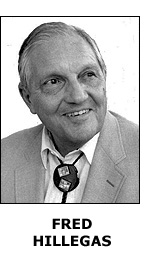 Which gets me to the news. While Walter Cronkite may have been America’s most trusted newsman, my parents put their faith in Fred Hillegas, at least for a report on what was happening in Onondaga County. For several years my mother made it a point to listen to Hillegas’s noon broadcast every day on WSYR. He was more important than Arthur Godfrey and her soap operas combined. Hillegas later became the Channel 3 anchorman, though he functioned more like a one-man operation than the captain of a news team. When Fred Hillegas spoke, Syracuse listened.
Which gets me to the news. While Walter Cronkite may have been America’s most trusted newsman, my parents put their faith in Fred Hillegas, at least for a report on what was happening in Onondaga County. For several years my mother made it a point to listen to Hillegas’s noon broadcast every day on WSYR. He was more important than Arthur Godfrey and her soap operas combined. Hillegas later became the Channel 3 anchorman, though he functioned more like a one-man operation than the captain of a news team. When Fred Hillegas spoke, Syracuse listened.